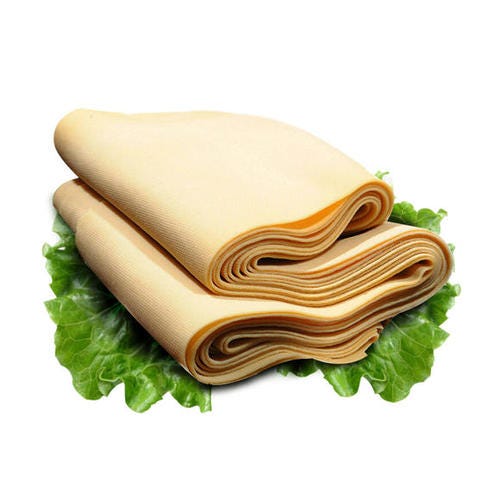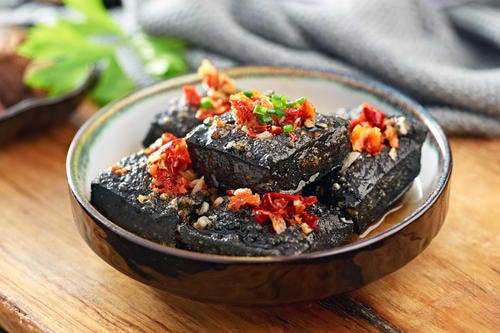A Running List of China’s 20+ Tofus
Before visiting China, I assumed tofu was just a pasty, white block.
I never would’ve imagined that tofus could melt… or that some varieties tasted like aged cheese… or that others had a bread-like crumb!
Chinese tofus are some of the most culinarily exciting plant-based proteins in existence. Yet, hardly anyone outside the Chinese community knows they exist!
Here’s my running list of China’s 20+ tofu varieties, starting with five especially popular types.
5 Popular Chinese Tofus

Pressed tofu (dougan):
Dougan is a category of extra firm tofu, pressed very dry and then smoked, stewed, or salted. While low in water content, many varieties are tender, rather than tough. The ingredient is eaten in most major regions of China, in stir fries, dumpling filling, and on the grill.

Yuba (youdoupi)
Youdoupi is the high protein film that collects atop heated soymilk, eaten as sheets or rolled into “tofu sticks” (fuzhu). Yuba sheets are often used as a wrap for other fillings, then fried and/or steamed. They’re also eaten with hotpot. Tofu sticks are usually sold dried and used in cold salads or light stir fries. They are widely eaten throughout the country.
(Unlike some of the other tofus on this list, yuba is not strictly Chinese. It’s also eaten across greater Asia.)

Tofu Sheets (qianzhang)
Qianzhang are cardstock-thin sheets of ground then pressed soycurds. Due to their minimal moisture content, qianzhang are the most protein-dense tofu. They also have very little beanyness. They’re most commonly eaten sliced in cold salads, and are popular in China’s northeast in fresh vegetable rolls and stir fries.

Spongy Tofu (qianye)
Qianye is a special type of tofu, made directly from soy protein, not whole beans. Its uniform texture is tender, chewy, and fishcake-like, which is described in Mandarin as simply the letter “Q”. One of the most forgiving tofus, it can be frozen indefinitely with little change to its structure, and it rarely breaks apart when cooking. Spongy tofu is usually stir fried, but it can also be grilled or baked. It’s most common in northern China.

Fermented Tofu (furu)
Furu is the flavor king of tofu. Made by fermenting cubes of firm tofu alongside spices, alcohol, and seasonings, it can develop notes ranging from provolone to blue cheese, salty and astringent to warm creamy. Fermented tofu is extremely rich in umami. Due to its softness and potent flavors, it’s usually eaten as an accompaniment to other foods, rubbed onto pastries, spooned on top of gravies, or mixed into dipping or stir fry sauces. It’s eaten all over China, and every city, town, and village makes it their own way.
5 Rare Chinese Tofus

Stinky Tofu (choudoufu)
Lovers say it “smells stinky but tastes fresh”. The most famous type of stinky tofu comes from Changsha and sports the black/deep blue color of mold. Taiwan also has several popular varieties. Both tend to be fried, grilled, or stewed, served street-side on a stick.

Shanghai Tofu (suji)
Suji is made by brining shredded tofu sheets in alkaline solution, then pressing them into a log structure. This transforms the old ingredient into a completely new form, while maintaining the ultra-high protein content and low beany taste. Shanghai tofu is usually fried and stewed, which gives it an indulgent creamy juiciness. Despite it’s deliciousness, it is rarely eaten outside the Shanghai region, except occasionally in Taiwan.

Juicy Tofu (baojiangdoufu)
Inland Yunnan Province has some of China’s most unique tofu varieties. One of the them, from Jianshui County, even melts. Grilled or fried, the tofu’s exterior hardens into an air-tight shell, encasing hot air pressurized air, which melts and transforms the inside curds. You won’t believe it till you try it.

Charcoal Tofu (qiaohuidoufu)
Guizhou is the unofficial tofu capital of the world, with over six of its own unique varieties. This one is made by rubbing fresh tofu with charcoal ash, then smoking it for 24 hours in warm embers. The ash’s alkalinity gives the tofu a unique chewy exterior, while the inside stays remarkably tender. This is one of the tastiest tofus to stew. It’s unfortunate that no one is making it outside of Guizhou.

Bubbly Tofu (paodoufu)
This is another variety only available in Guizhou Province. Thin paodoufu sheets are dried in the sun until dry and brittle, then baked in a large wok filled with hot stones, causing the tofu to puff up. When soaked in water and reconstituted, bubbly tofu maintains its firm, porous structure, which resists breakage and allows for maximum flavor absorption. This is a highly versatile ingredient that’s entirely shelf stable.
If you want to learn more about China’s other 20+ tofu varieties, here’s a running list.
Where possible, I linked to a Chinese Wikipedia entry. Simply translate in your browser to your preferred language.
- 老豆腐 — firm (including extra- , super- , and medium-firm)
a. 豆泡 — fried tofu puffs
2. 嫩豆腐 — soft
3. 内酯豆腐 — silken
a. 豆花/豆腐脑 — fresh tofu pudding
b. 菜豆花 — vegetable tofu pudding
4. 豆腐干 — pressed tofu
a. 卤豆干 — stewed
b. 烟熏/香干 — smoked
5. 油豆皮/腐竹 — yuba/tofu skin/ tofu sticks
6. 千张/干豆腐/干豆皮/ — tofu sheets
a. 豆腐丝 — shredded tofu sheets
7. 素鸡 — Shanghai tofu
8. 千页豆腐 — spongy tofu
9. 冻豆腐 — frozen tofu
10. 豆腐乳 — fermented tofu
11. 臭豆腐 — stinky tofu
12. 毛豆腐 — hairy tofu
13. 大方手撕豆腐 — hand-ripped tofu
14. 荞灰豆腐 — charcoal tofu
15. 烟熏豆腐 — Guizhou smoked tofu
16. 爆浆小豆腐 — exploding juice tofu
17. 青岩豆腐 — Qingyan village tofu
18. 泡豆腐/脚板豆腐皮 — puffy tofu
19. 金钱豆腐 — tofu coins
20. 石屏豆腐 — Shiping (Yunnan) tofu
21. 腊八豆腐 — Anhui salted and smoked tofu
22. 建水包浆豆腐 — Jianshui (Yunnan) juicy tofu
23. 脆豆腐 — dried, porous tofu
24. 麻豆腐 — stir-fried mung bean okara
25. 黑豆豆腐— black soybean tofu
26. 花生豆腐 — peanut tofu
27. 鹰嘴豆腐 — chickpea tofu
28. 杏仁豆腐 — almond tofu
